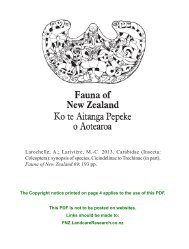PDF File - Landcare Research
PDF File - Landcare Research
PDF File - Landcare Research
Create successful ePaper yourself
Turn your PDF publications into a flip-book with our unique Google optimized e-Paper software.
Gall-Formers on Black Wattle:<br />
Uninvited but Welcome<br />
Black wattle (Acacia mearnsii) was planted widely in the<br />
Waikato in the late 19th and early 20th century as its bark was<br />
useful for tanning. The tree quickly escaped from plantations<br />
and naturalised. While black wattle is still sometimes<br />
planted for fi rewood or as an ornamental tree, it is known<br />
to be invasive. A native of Australia, this tree has become<br />
problematic in so many other countries that it is included in<br />
a list of “100 of the world’s worst invasive alien species”, and<br />
until recently it was probably only a matter of time before it<br />
lived up to its reputation here too.<br />
On a recent visit to New Zealand, Dr Robin Adair (Department<br />
of Primary Industries, Australia) noticed a tiny gall-forming<br />
insect on black wattle trees near a motorway in Hamilton.<br />
Robin recognised it as the tiny fl oret galler (Dasineura<br />
rubiformis) as he helped to formally describe and name it<br />
in Australia. The insect develops in the ovaries of wattle<br />
fl owers causing them to form sterile galls instead of seeds.<br />
The galled fl owers look a bit like berry fruits, hence the name<br />
‘rubiformis’. “I could tell that the insect had been present for<br />
at least 2 years because there were old, mummifi ed galls from<br />
previous years as well as fresh new ones,” explained Robin.<br />
The fl y is likely to have self introduced here and already be<br />
quite widespread, as it disperses readily. Adults emerge when<br />
wattles are fl owering in the spring, and they mate, deposit<br />
eggs and die within a few days. Larvae develop slowly and<br />
don’t emerge from the galls until the following winter when<br />
they pupate in the soil.<br />
Gall-forming fl ies are common on Acacia species and<br />
most have a narrow host range. The tiny fl oret galler only<br />
attacks three Acacia species: A. mearnsii, A. irrorata, and<br />
A. paramattensis. These three species are all very closely<br />
related (in the subgenus Phyllodineae, section Botrycephalae)<br />
and they all have bipinnate leaves. A. irrorata is not present<br />
in New Zealand and A. paramattensis has naturalised but<br />
is not particularly common or useful here, so the tiny fl oret<br />
galler should not cause problems for any valued acacias. In<br />
any case, the actual trees are not harmed, with only seed<br />
production affected. This gall former has been deliberately<br />
released in South Africa where it is considered to be a<br />
successful biocontrol agent for black wattle.<br />
Rust fungi in the genus Uromycladium also produce galls on<br />
black wattle. Seven species have arrived from Australia and<br />
attack wattles here. Four of them cause disease symptoms<br />
(lesions and pustules/galls) on black wattle: Uromycladium<br />
acacia, U. alpinum, U. notabile and U. robinsonii. Of these,<br />
U. notabile causes the most damage. Indeed, 1800 ha of<br />
black wattle planted in the hope of starting a tanning industry<br />
Galls caused by the tiny fl oret galler on Acacia mearnsii.<br />
had to be felled in the 1920s because of heavy infection by<br />
this pathogen. U. nobile causes large blackish/brown galls<br />
(typically 2–8 cm in diameter, but they can get as big as 35<br />
cm) on leaf petioles, stems, branches and mature seed pods.<br />
Galls continue to grow for several seasons and restrict water<br />
movement through the tree. Lack of water results in poor<br />
growth beyond the galls, and when infection is severe, whole<br />
trees can be killed in a couple of years. Like the tiny fl oret<br />
galler, U. notabile is restricted in its host range to a subset of<br />
Acacia species with bipinnate leaves.<br />
No studies have been done on the impacts of Uromycladium<br />
gall rusts or the tiny fl oret galler on black wattle in New<br />
Zealand. However, it is probably safe to say that both are<br />
useful additions to our fauna given black wattle’s weedy<br />
reputation. We would be interested to hear about any<br />
additional sightings of the tiny fl oret galler here. Also keep an<br />
eye out for other interesting beasties on acacias here, as other<br />
natural enemies are also likely to make their way over the ditch<br />
in the future.<br />
For more information about gall fl ies that attack acacias see:<br />
Kolesik P, Adair RJ, Eick G 2005. Nine new species of<br />
Dasineura (Diptera: Cecidomyiidae) from fl owers of Australian<br />
Acacia (Mimosaceae). Systematic Entomology DOI:10.1111/<br />
j.1365-3113.2005.00287.x<br />
CONTACT: Jane Barton (jane.barton@ihug.co.nz)<br />
3<br />
Robin Adair
















